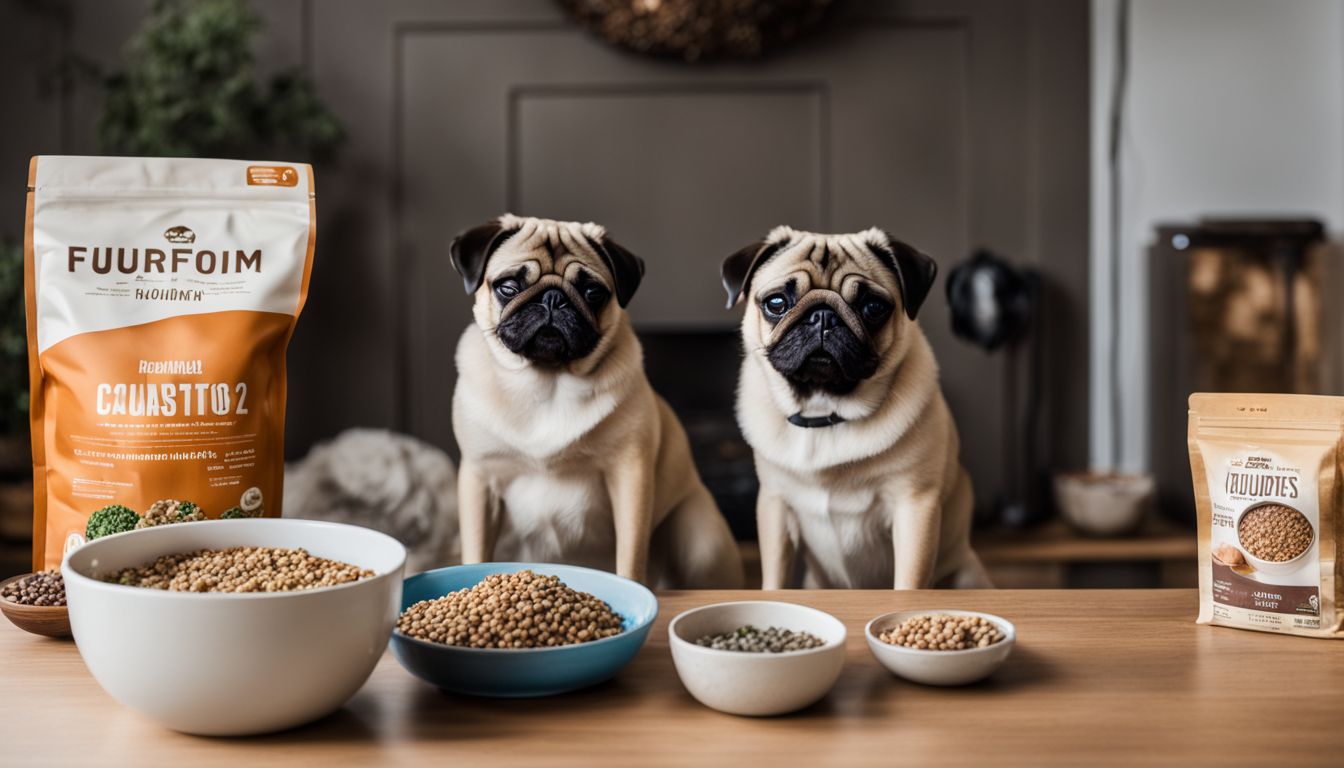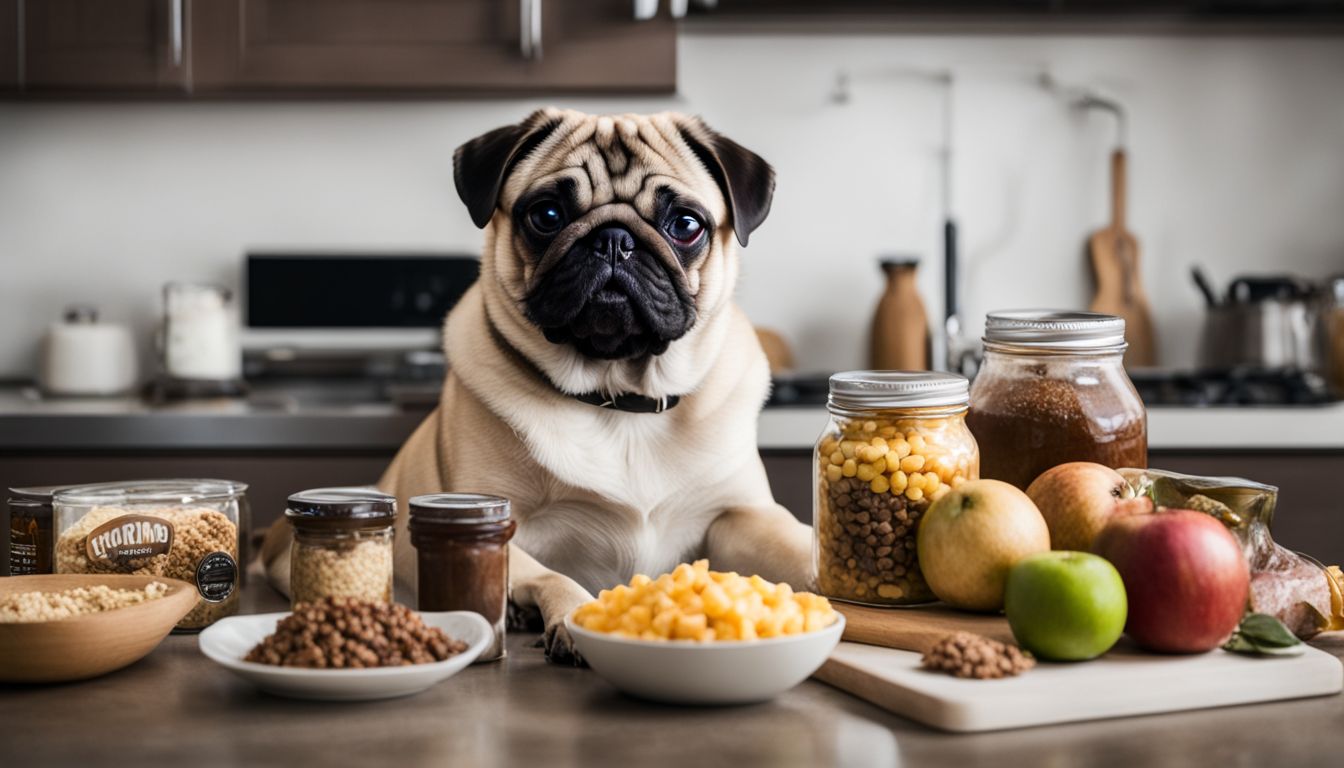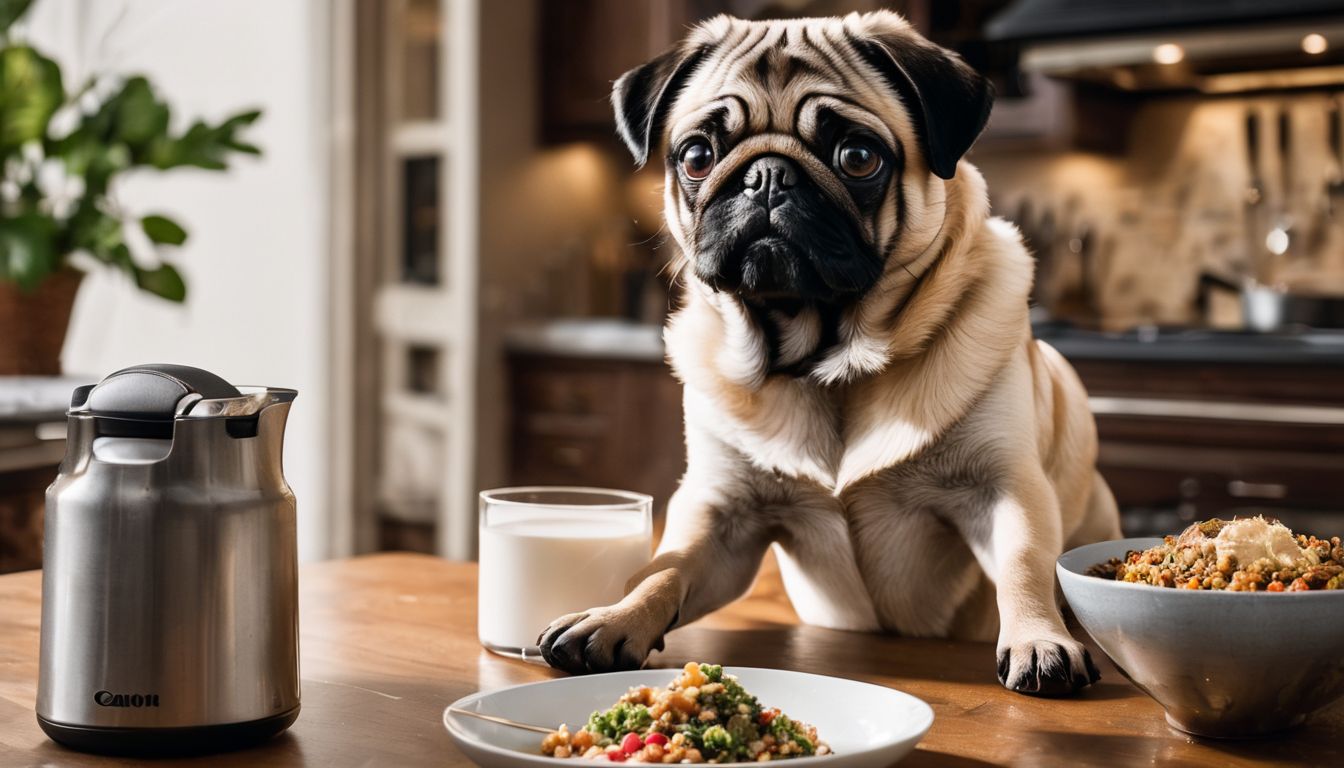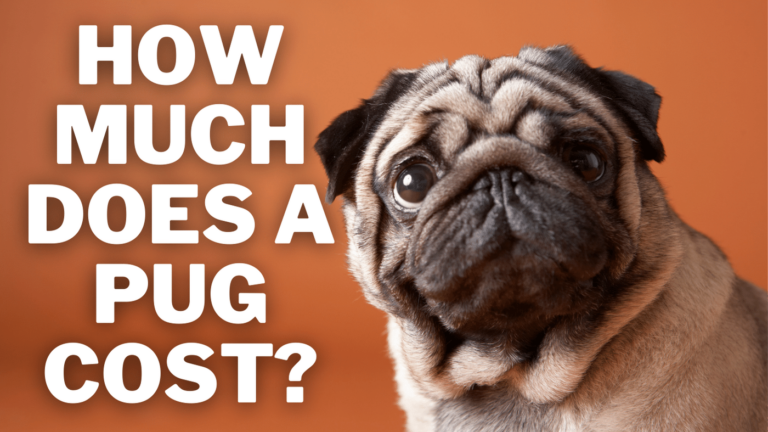What Do Pugs Eat? A Comprehensive Guide To Their Diet And Nutrition
What Do Pugs Eat?
Are you scratching your head over what to dish out for your adorable pug to keep them wagging and thriving? You’re definitely not in the doghouse alone; as avid pug lovers ourselves, we totally get the quest for the perfect meal plan.
Feeding our squishy-faced friends a diet that’s chock-full of nutrients is absolutely crucial. So, let’s roll up our sleeves and dig into the nitty-gritty of what makes a top-notch menu for these lovable furballs.
We’ve got some tail-wagging nutrition tips coming right up that are sure to have your pug jumping for joy!
Key Takeaways
- Pugs thrive on a balanced diet with real meat, healthy carbs, and essential vitamins and minerals. Avoid toxic foods like chocolate, onions, grapes, and caffeine.
- A pug’s dietary needs change as they grow; puppies require frequent meals rich in proteins and omega-3 fatty acids while senior pugs benefit from lower-calorie foods with joint support supplements.
- Healthy treats are crucial for reinforcing positive behavior during training; consider lean meats, fresh veggies, or homemade biscuits using safe ingredients.
- Monitor your pug’s portion sizes to prevent obesity. Use feeding guidelines specific to age and size but adjust based on the dog’s activity level.
- Always provide plenty of clean water alongside nutritious food options to keep your pug well-hydrated through all life stages.
What Do Pugs Eat?

Pugs need a diet full of proteins, fats, carbs, and essential vitamins and minerals. We make sure real meat tops the ingredient list in their meals because it’s crucial for their muscle development and overall health.
Carbs are also key; we include healthy options like rice or wheat to give our pugs the energy they need without risking obesity from too many calories.
We always check labels to avoid foods that could harm our little friends. Foods should be free of harmful additives and rich in nutrients like omega-3 fatty acids to support their joints, which is especially important considering how playful pugs can be.
Incorporating dog foods with a balanced nutrient profile helps maintain a healthy weight and keeps our pug’s digestive system working smoothly.
Foods to Avoid for Pugs

After exploring the wholesome foods that contribute to a pug’s diet, it’s just as crucial to be aware of what they shouldn’t eat. Pugs have sensitive stomachs and it’s our responsibility as pug owners to protect them from harmful foods.
- Chocolate is a big no for pugs. It contains theobromine, which dogs cannot metabolize well, leading to potential poisoning.
- Caffeinated beverages and food items can cause rapid heart rate and seizures in dogs, so keep coffee, tea, and soda out of your pug’s reach.
- Onions and garlic may add flavor to our meals but are toxic for dogs; eating these can lead to anemia by destroying red blood cells.
- Grapes and raisins seem harmless but can cause sudden kidney failure in pugs even in small amounts.
- Macadamia nuts are known to be toxic for dogs, causing symptoms like weakness, depression, vomiting, tremors, and hyperthermia.
- Avocado contains persin which is harmless for humans but can cause vomiting and diarrhea in dogs.
- Alcohol has no place in a dog’s diet; even small amounts can lead to intoxication or worse.
- Bones from fish or chicken should always be avoided as they could splinter and choke or damage a pug’s internal organs if swallowed.
- Xylitol is an artificial sweetener often found in sugar-free products that can trigger insulin release leading to liver failure in dogs.
- High salt content food such as chips or pretzels can induce sodium ion poisoning resulting in symptoms like vomiting, diarrhea, tremors, and seizures.
- Green tomatoes contain solanine which might be toxic for dogs causing gastrointestinal upset; ripe tomatoes are usually safe but moderation is key.
Diet for Pug Puppies
Ensuring your Pug puppy thrives starts with a well-balanced diet, tailored to support their rapid growth and boundless energy—discover how to nourish their playful spirit by reading on.
Suitable foods for puppies
Our pug puppies deserve the best start in life, and that includes a diet rich in all the right nutrients. Good nutrition habits are crucial to lay the foundation for their health and happiness. Here’s what we can feed our little ones:
- Real meat is key, so let’s give our pups food that lists chicken, beef, or lamb as the first ingredient. This provides them with essential proteins for muscle growth.
- Rice, soy, or wheat should be included as a source of carbohydrates for sustained energy throughout their playful days.
- Carrots make a great addition to their diet as they are high in fiber and vitamin A which supports eye health.
- Puppy-specific formulas often contain fish oils; these are excellent sources of omega-3 fatty acids aiding in brain development.
- We can occasionally add small amounts of plain yogurt to provide calcium for strong bones and probiotics for gut health.
- Always ensure clean, fresh water is available to keep our puppies well-hydrated after all their energetic activities.
Feeding recommendations for a Pug puppy with a normal activity level
For your Pug puppy’s meals, aim to serve food that’s high in quality protein with real meat as the first ingredient. They need a balanced blend of proteins, fats, and carbohydrates for their development.
Make sure their diet includes plenty of vitamins and minerals too. Typically, puppies require more frequent feedings than adult dogs – about three to four times a day.
Keep an eye on portion sizes; overfeeding can lead to unwanted weight gain. Consult feeding guidelines specific to your pup’s age and size, but generally speaking, start with what’s recommended on the dog food package based on their weight category.
As they grow and expend energy through play and training sessions, you’ll get a better sense of the right amount for them. Remember always ensure fresh water is available at all meal times for optimal hydration alongside their nutritious diet.
Adult Pug Diet
Understanding the dietary needs of your adult Pug is crucial for maintaining their health and happiness; dive deeper to explore how tailored nutrition can optimize their well-being.
Recommended wet food for adult Pugs
As Pug lovers, we want the best for our furry friends, especially when it comes to their meals. Wet food can be a tasty and hydrating option for adult pugs, offering both nutrition and flavor.
- Look for wet dog foods that list real meat as the first ingredient. This ensures your pug is getting high-quality protein essential for muscle maintenance.
- Choose options rich in omega 3 fatty acids. Foods containing fish oils or linseed will support your pug’s skin health and coat shine.
- Seek out brands that include vegetables like carrots and peas. These provide necessary vitamins and antioxidants, contributing to overall health.
- Opt for canned food with high moisture content. It aids in hydration, which is particularly beneficial if your pug doesn’t drink enough water.
- Prioritize foods that are free from artificial colors, flavors, or preservatives. Natural ingredients are less likely to cause adverse reactions or allergies.
- Consider brands that tailor their formulas for small breeds like pugs. These are designed to meet their energy needs and support their specific physique.
- Ensure the food contains dietary fiber sources such as inulin. A high-fibre wet food will promote healthy digestion and bowel movements.
- Verify the calorie count per serving to avoid overfeeding. An appropriate energy content helps maintain a healthy weight in adult pugs.
- Check if the food includes added vitamins like Vitamin C, which can offer benefits such as supporting immune health and possibly reducing inflammation associated with rheumatoid arthritis.
- If your pug has a sensitive stomach, explore specialized formulas such as Royal Canin Pug Adult wet food tailored for digestive comfort.
Recommended dry food for adult Pugs
We want our adult Pugs to thrive, so choosing the right dry food for them is crucial. Let’s dive into some top recommendations that cater to their nutritional needs and keep their tails wagging.
- Look for bags of dry dog food where real meat, such as chicken or turkey, tops the ingredient list, because Pugs need plenty of proteins to maintain muscle mass.
- Select formulas that include whole grains or sweet potatoes to provide the necessary carbohydrates that give your Pug energy throughout the day.
- Ensure the food has a balanced blend of omega-3 and omega-6 fatty acids to support skin health and give your Pug a glossy coat.
- Opt for brands that fortify their foods with vitamins and minerals like calcium for bone health and antioxidants for immune system support.
- Choose kibble designed specifically for small breeds as it’s easier for Pugs to pick up and chew, promoting better dental health.
- Consider dry food options like Royal Canin pug food, which is tailored to meet the unique needs of a Pug’s sensitive stomach and helps maintain an ideal weight.
- Check that there are high-fibre ingredients in the mix, aiding digestion and helping prevent any issues with constipation.
- Avoid foods with artificial preservatives, colors or flavors since natural ingredients are always healthier for your beloved pet.
Senior Pug Diet
As our beloved pugs reach their senior years, it’s crucial to adjust their diet to maintain optimal health—discover the specialized nutrition they require to thrive in this golden stage of life.
Recommended wet food for senior Pugs
Senior Pugs have unique dietary needs that we must carefully consider. Wet food can provide them with the necessary hydration and is easier to eat, especially for those with dental issues. Here’s what we recommend for your aging companion:
- Choose brands that list real meat as the first ingredient to ensure high-quality protein, which is crucial for maintaining muscle mass in senior dogs.
- Look for wet foods specifically formulated for senior dogs; these often contain a balance of nutrients tailored to the needs of older pets.
- Pick products with added glucosamine and chondroitin, which support joint health and can be beneficial for Pugs prone to arthritis.
- Ensure the wet food includes omega fatty acids to promote healthy skin and coat, which can become lackluster as Pugs age.
- Opt for foods with easily digestible carbohydrates like rice or sweet potatoes to provide energy without overworking their digestive system.
- Select cans or pouches with lower calorie content per serving to help manage weight since senior Pugs are less active and prone to obesity.
- Incorporate wet foods that boast a blend of antioxidants; these combat free radicals and support immune health in older dogs.
- Include fiber – rich ingredients to foster good bowel movements, aiding in preventing constipation, a common issue in senior dogs.
Recommended dry food for senior Pugs
As our pugs reach their golden years, their dietary needs change. It’s crucial we choose the right dry food that supports their health and vitality. Here’s a list of recommended dry foods specifically formulated for senior pugs:
- Look for brands that offer senior – specific formulas with reduced calorie content to prevent weight gain, as older pugs are less active.
- Choose dry food options that contain high – quality protein sources such as chicken or fish to maintain muscle mass without overburdening the kidneys.
- Ensure the food has added joint – supporting nutrients like glucosamine and chondroitin, which are essential for preserving joint health in aging dogs.
- Opt for kibble tailored to senior dogs, which includes antioxidants like vitamin E and beta – carotene to strengthen immune systems in older pugs.
- Find formulas rich in omega-3 and omega-6 fatty acids to keep your senior pug’s skin healthy and their coat shiny.
- Pick products with easily digestible fibers, such as beet pulp or psyllium, which aid in maintaining good digestive function.
- Avoid foods with artificial preservatives or colors; natural preservatives like tocopherols (forms of vitamin E) are safer choices for your dog’s long-term health.
- Select kibbles designed with smaller-sized pieces that make chewing easier for senior pugs who may have dental issues.
Feeding recommendations for a senior Pug
Senior Pugs need a diet that’s easy on their aging bodies but still full of the nutrients they require. We should focus on low-calorie foods to prevent weight gain, which could put extra stress on their joints.
Their meals might also benefit from added supplements like glucosamine and chondroitin, which support joint health. High-quality proteins are essential for maintaining muscle mass, so let’s ensure any dry or wet food we pick lists real meat as the first ingredient.
We’ve got to be careful with portion sizes too because overfeeding can lead to obesity in senior Pugs. Every dog is different, and activity levels can vary, so feeding guidelines must be adjusted to our senior Pug’s lifestyle.
It’s best to split their daily intake into two smaller meals rather than one large one; this helps keep their metabolism steady and supports better digestion throughout the day. And while treats are fine every now and then, let’s remember they’re just like us: moderation is key!
Treats and Snacks for Pugs
In our journey to provide the best care for our pugs, we can’t overlook the joy and benefits of treats and snacks. They not only serve as a token of love but also reinforce positive behavior during training sessions.
Let’s explore healthy options that will satisfy their taste buds without compromising their diet. Join us as we delve into crafting nutritious homemade dog treats that your pug will adore!
Healthy options for treats
We know how much pug owners love spoiling their furry friends with treats. However, it’s crucial to choose healthy options that benefit their diet and well-being.
- Opt for small pieces of lean meat like chicken or turkey as they are high in protein and low in fat.
- Incorporate fresh vegetables such as carrots and green beans, which offer vitamins and crunch your pug will love.
- Offer bite – sized chunks of apple or blueberries for a sweet treat packed with antioxidants — just remove any seeds first.
- Consider rice cakes or plain popcorn without salt and butter for a light, occasional snack.
- Look into specially formulated dog treats that cater to the dietary needs of pugs, ensuring they contribute positively to their nutrition.
- Explore natural dental chews that not only satisfy the urge to gnaw but also promote oral health.
- Prepare homemade dog biscuits using whole ingredients like pumpkin, peanut butter (without xylitol), and oats for a personalized touch.
- Select treats fortified with essential fatty acids to support coat health; some commercial treats are designed with this in mind.
- Freeze small portions of low – fat yogurt or cottage cheese for a refreshing snack, especially in warmer months.
Making homemade dog treats
Healthy options for treats set the stage for us to dive into crafting our very own homemade dog treats. These tasty rewards not only bring joy to our pugs but also give us peace of mind about what we’re feeding them.
- Choose real meat, such as chicken or beef, as the base for protein-packed snacks. Ensure it’s cooked well and free from any seasonings that could harm your pug.
- Incorporate pureed vegetables like carrots or pumpkin for an added vitamin boost; these are gentle on a pug’s stomach and aid in digestion.
- Use oatmeal or rice flour instead of wheat if your pug has sensitivities; these grains are less likely to cause allergic reactions.
- Mix in eggs as a binding agent; they offer extra protein and help create a chewy texture in baked treats.
- Add applesauce for natural sweetness instead of sugar; it’s healthier and most dogs love the taste.
- Keep it simple with peanut butter; just make sure it’s xylitol – free since this sweetener is toxic to dogs. A little peanut butter can make any treat irresistible to your pup.
- Avoid chocolate, grapes, raisins, onions, and foods high in caffeine. Stick with ingredients listed on safe food guides for dogs to keep your treats non-toxic.
- Roll out dough on a floured surface and cut into fun shapes using cookie cutters. Pugs will appreciate the size-appropriate pieces that are easy to chew.
- Bake treats until crisp but not too hard; softer treats are easier on a senior pug’s teeth.
- Experiment with dehydrating fruits like slices of apple or banana. Dehydrated fruits can be chewy or crunchy depending on how long they’re dried.
- Store homemade treats properly in an airtight container; this keeps them fresh longer and preserves their flavor and texture.
What Do Pugs Eat? Conclusion
In sum, feeding your pug the right foods is crucial for their well-being. Keep their meals balanced with high-quality proteins, fats, and carbohydrates while steering clear of harmful foods.
Remember to tailor your pooch’s diet through every stage of life – from playful puppy to dignified senior. Offer treats wisely and enjoy making nutritious snacks that keep tails wagging.
With these guidelines, you’re all set to nourish your pug for a vibrant and healthy life by their side!
What Do Pugs Eat? FAQs
1. What should a healthy diet for pugs include?
A healthy diet for pugs should consist of dog food that meets their nutritional needs, as recommended by the American Society for the Prevention of Cruelty to Animals. It’s important to give them a balanced mix of proteins, carbohydrates, fats, vitamins, and minerals.
2. Can pugs eat human food?
While some human foods are safe for pugs in small amounts, it is vital to feed them only foods that are non-toxic to dogs. Always check with your vet before introducing any new food into your pug’s diet.
3. How much food does my pug need each day?
The amount of food a pug needs can vary based on their size, age, and activity level. View the recommendations on the dog food package or consult your veterinarian for advice on complete and proper daily portions specific to your pet.
4. Should I change my pug’s diet as they get older?
Yes! As dogs age their dietary needs change too. Transitioning to age-appropriate dog food will help maintain health throughout each stage of life; always select foods designed specifically for their current life phase.







